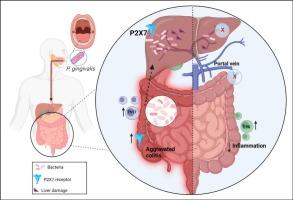Role of the P2X7 receptor in intestinal inflammation due to infection with the oral pathogen Porphyromonas gingivalis
IF 5.1
2区 医学
Q1 MEDICINE, RESEARCH & EXPERIMENTAL
引用次数: 0
Abstract
Porphyromonas gingivalis (P. gingivalis), a Gram-negative bacterium present in the oral cavity, is one of the primary pathogens associated with periodontitis. P. gingivalis has also been linked to other non-oral pathologies, such as diabetes, colorectal cancer, and inflammatory bowel disease. The P2X7 receptor plays a role in resolving oral infection with P. gingivalis, and, separately, is associated with increased damage in colitis. This study investigated whether ingestion of P. gingivalis could aggravate colitis and whether the P2X7 receptor could play a role in this effect. Wild-type (WT) and P2X7-deficient mice were orally inoculated by gavage with P. gingivalis, and colitis was induced by intrarectal injection with 2,4,6-trinitrobenzene sulfonic acid (TNBS). P. gingivalis ingestion upregulated P2X7 receptor immunoreactivity in the colon of WT mice. P. gingivalis also triggered intestinal inflammation and reduced the colon length in WT mice but not P2X7-deficient mice. The balance of regulatory T (Treg) cells and Th17 cells of the mesenteric lymph node was perturbed in WT mice that had been administered P. gingivalis and TNBS, while this was not observed in P2X7-deficient mice. Th17 cells were increased in WT mice in response to P. gingivalis, while P2X7-deficient mice showed an increase in Treg cells. P. gingivalis ingestion induced liver injury in WT mice, but not in P2X7-deficient mice. Furthermore, the liver from WT mice that had been administered P. gingivalis and TNBS showed higher levels of bacteria than P2X7-deficient mice. Our findings suggest that the P2X7 receptor contributes to the deleterious effects of P. gingivalis on gut inflammation and liver damage.

P2X7受体在口腔病原菌牙龈卟啉单胞菌感染引起的肠道炎症中的作用
牙龈卟啉单胞菌(P. gingivalis)是存在于口腔中的革兰氏阴性细菌,是与牙周炎相关的主要病原体之一。牙龈卟啉卟啉菌还与其他非口腔疾病有关,如糖尿病、结直肠癌和炎症性肠病。P2X7受体在解决牙龈假单胞菌口腔感染中起作用,并且单独与结肠炎损伤增加有关。本研究探讨摄入牙龈假单胞菌是否会加重结肠炎,以及P2X7受体是否在这一作用中发挥作用。野生型(WT)和p2x7缺陷小鼠灌胃接种牙龈卟啉单胞菌,直肠内注射2,4,6-三硝基苯磺酸(TNBS)诱导结肠炎。吞入牙龈假单胞菌可上调WT小鼠结肠中P2X7受体的免疫反应性。在WT小鼠中,牙龈卟啉卟啉菌也会引发肠道炎症并缩短结肠长度,而p2x7缺陷小鼠则不会。在给予牙龈卟噬菌和TNBS的WT小鼠中,肠系膜淋巴结的调节性T (Treg)细胞和Th17细胞的平衡受到干扰,而在p2x7缺陷小鼠中没有观察到这种情况。WT小鼠的Th17细胞增加,而p2x7缺陷小鼠的Treg细胞增加。吞下牙龈卟啉单胞菌可引起WT小鼠的肝损伤,而p2x7缺陷小鼠则无肝损伤。此外,与p2x7缺陷小鼠相比,给予牙龈卟啉卟啉和TNBS的WT小鼠的肝脏显示出更高的细菌水平。我们的研究结果表明,P2X7受体参与了牙龈假单胞菌对肠道炎症和肝损伤的有害作用。
本文章由计算机程序翻译,如有差异,请以英文原文为准。
求助全文
约1分钟内获得全文
求助全文
来源期刊

Life sciences
医学-药学
CiteScore
12.20
自引率
1.60%
发文量
841
审稿时长
6 months
期刊介绍:
Life Sciences is an international journal publishing articles that emphasize the molecular, cellular, and functional basis of therapy. The journal emphasizes the understanding of mechanism that is relevant to all aspects of human disease and translation to patients. All articles are rigorously reviewed.
The Journal favors publication of full-length papers where modern scientific technologies are used to explain molecular, cellular and physiological mechanisms. Articles that merely report observations are rarely accepted. Recommendations from the Declaration of Helsinki or NIH guidelines for care and use of laboratory animals must be adhered to. Articles should be written at a level accessible to readers who are non-specialists in the topic of the article themselves, but who are interested in the research. The Journal welcomes reviews on topics of wide interest to investigators in the life sciences. We particularly encourage submission of brief, focused reviews containing high-quality artwork and require the use of mechanistic summary diagrams.
 求助内容:
求助内容: 应助结果提醒方式:
应助结果提醒方式:


